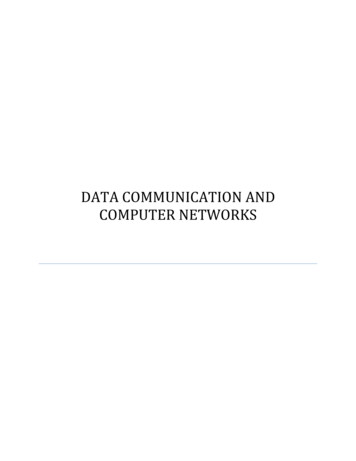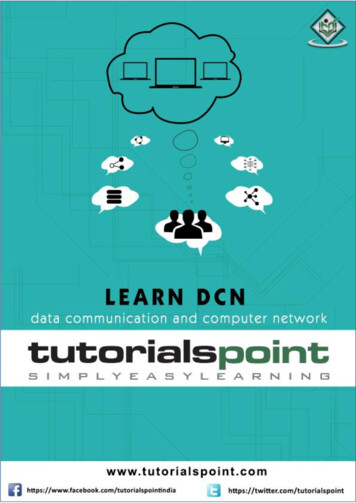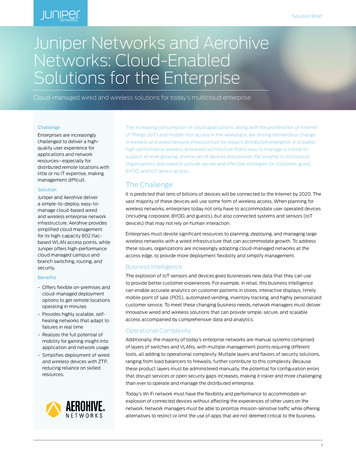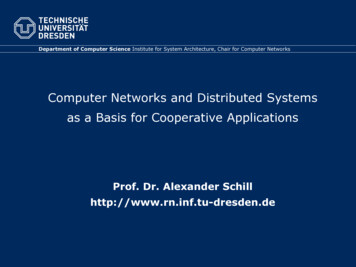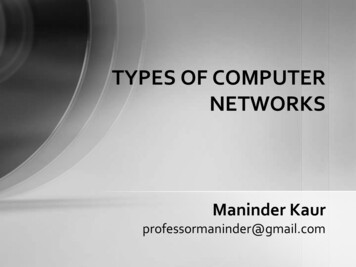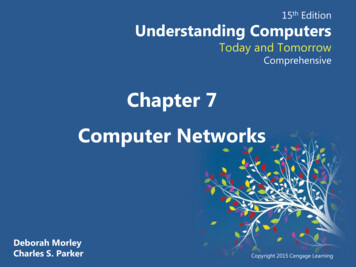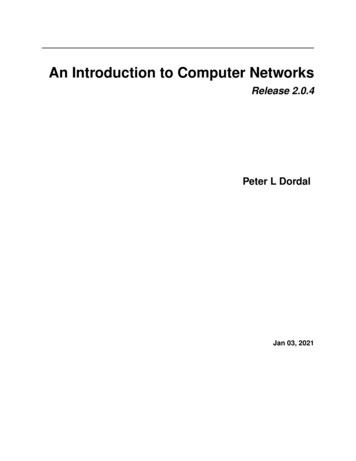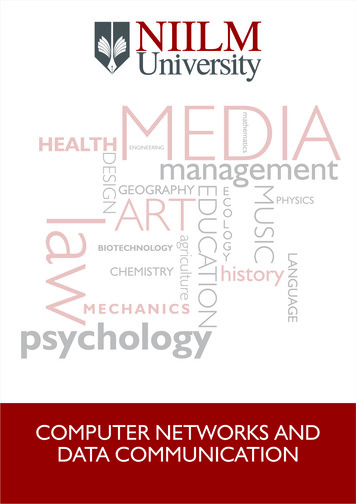
Transcription
entHEALTHCOMPUTER NETWORKS ANDDATA COMMUNICATION
Subject: COMPUTER NETWORKS AND DATA COMMUNICATIONCredits: 4SYLLABUSData Communications FundamentalsCommunication model, computer communications architecture, OSI model, TCP/IP, standards, signals, analogand digital transmission, transmission media, line configuration, topologies, data communications codes, errordetection and correction methods.Data Modem & ModulationData encoding methods, analog to digital, digital to analog etc., data modulation methods: ASK, FSK, PSK,QAM, M-ary systems. Data modems: modulation interface, operation on 2 wire, 4 wire and dial up lines.Data Communications MethodsData communication interface, line control unit, UART, USRT, Serial interface, terminal types.Data Link Control & MultiplexingFlow control, error detection & control, IBM Bisync protocol, SDLC, HDLC, HDLC line procedures, timedivision multiplexing (TDM), FDM, line encoding, carriers.Data Communication NetworkingSwitched networks, circuit switching, packet switching, broadcast networks, LAN, WAN topologies, ATM &Frame relay, cell relay.Suggested Readings:1. Data Communications and Networking, Fourth Edition by Behrouza A. Forouzan,TMH2. Computer Networks,A.S.Tanenbaum,4th edition,Pearson education3. Introduction to Data communications and Networking,W.Tomasi,Pearson education4. Data and Computer Communications,G.S.Hura and M.Singhal,CRC Press,Taylor and Francis Group5. An Engineering Approach to Computer Networks-S.Keshav,2nd Edition,Pearson Education6. Understanding communications and Networks,3rd Edition, W.A.Shay,Cengage Learning
COMPUTER NETWORKS AND DATA COMMUNICA TIONCOMPUTER NETWORKS AND DATA COMMUNICATIONCOURSE OVERVIEWThis course presents an overview of data communications anddetail. The Transport Layer includes the transport service,computer networks, including network hardware and networkelements of transport protocols, and a detailed presentation ofsoftware, as well as reference models, example networks,TCP and UDP internet transport protocols. The Applicationexample data communication services and network standardiza-Layer issues cover major Internet applications, such as, DNStion. The ISO and the Internet (TCP/IP) computer network(Domain Name System), Electronic Mail, FTP and the Worldmodels are discussed in details. The course covers each networkWide Web. It also includes an introduction to the main networklayer in details, starting from the Physical layer to the Applica-security principals.tion layer. It also includes an overview of network securitytopics. The physical network layer covers a guided and wirelesstransmission media, the telephone system, and Internet accessnetworks, such as DSL, ISDN and Cable modem. It alsopresents and overview of ATM networks. The Data Link Layercovers design issues, error detection and correction, elementarydata link protocols, sliding window protocols and example datalink protocols. The Medium Access Sub-layer covers thefollowing subjects: the channel allocation problem, multipleaccess protocols, IEEE standard 802 for LAN’s and MAN’s,bridges, high-speed and wireless LAN’s. However, withphenomenal advances in fields like Local Area Networks(LANs), client/server architecture and the advent of high speedIt is now feasible to connect the best of desktops, minis andmainframes, and to bring them in a common orbit with theobjective of enhancing organizational productivity. Thedramatic improvement in microprocessor power per dollar andthe pressure towards globalization are also accelerating the trendtowards distributed and desktop oriented computing. Theongoing construction of the digital Information Superhighway,the escalating importance of the Internet, the rush to buildsecure and reliable Internet applications for electronic commerce,and the emergence of new computing paradigms such asnetwork computing have created a new vista of opportunitiesand challenges for Information Technology (IT) managers.technologies such as ADSL, Frame Relay and ATM, thenetwork has become inseparable from the computers it linkstogether.The functions of the Network Layer are explained in context ofdesign issues, routing algorithms, congestion control andinternetworking. The IPv4 and IPv6 protocols are covered ini
COMPUTER NETWORKS AND DATA COMMUNICA TIONCOMPUTER NETWORKS AND DATA COMMUNICATIONCONTENT.Lesson No.TopicPage No.Data Communication FundamentalsLesson 11Lesson 23Lesson 36Lesson 48Lesson 510Lesson 6Line Configuration, Topologies12Data Modem & ModulationLesson 714Lesson 815Lesson 916Lesson 1018Data Communications MethodsLesson 1119Data Link Control & MultiplexingLesson 1220Lesson 1323Lesson 1425Lesson 1526Lesson 1628Lesson 1730Lesson 1832Lesson 1934Lesson 2036iii
COMPUTER NETWORKS AND DATA COMMUNICA TIONCOMPUTER NETWORKS AND DATA COMMUNICATIONCONTENT.Lesson No.TopicPage No.Data Communication NetworkingivLesson 2138Lesson 2240Lesson 2342Lesson 2443Lesson 2545Lesson 2647
UNIT IDATA COMMUNICATION FUNDAMENTALSLESSON 1 Communication and data communication A transmission system The basic data communication modelObjectivesUpon completion of this Lesson, you should be able to: Explain how data communication happens Explain the basic data communication model1.1 CommunicationWhat is communication?You are right! It is just exchange of information between twohumans.Data communication is similarly exchange of informationbetween two computers.We will first see a basic data communication model before weproceed any further.1.2 Basic Communication ModelCommunication defined more technically can be described asthe conveyance of a message from one entity, called the sourceor transmitter, to another, called the destination or receiver,via a channel of some sort.A very basic example of such a communication system isconversation; people commonly exchange verbal messages, withthe channel consisting of waves of compressed air molecules atfrequencies, which are audible to the human ear. This is depictedin Figure 1.1.The conveyance of a message could be followed by a reciprocalresponse message from the original destination (now a source)to the original source (now a destination) to complete one cyclein a dialogue between corresponding entities. Depending on theapplication or need for the information exchange, either atomicone-way transactions or a two-way dialogue could be appropriate.Now how do you make out that the message has correctlyreached the destination?In our example of conversation between two people- thereceiver would usually acknowledges the receipt of the messageeither by nodding his head or with some reply like ‘Iunderstand’ . This acknowledged form of dialogue is the basisof reliable communication - somehow the source must getfeedback that the destination correctly received the message.The basic model explained above wherein originator anddestination are human beings can be generalized as in Figure1.2. To suit the data communication between two systemsexchanging information between them.1.3 Data CommunicationSo in data communication who is the sender and the receiver?Let us try to understand this along with a few definitions.1.3.1 SourceDevice that generates the data to be passed on to theDestination device. It could be a user computer trying to makea query to a server computer.1.3.2 TransmitterIf the data generated by the Source device has to be transmittedthrough Transmission Channel or Transmission Systemthen it has to be presented in a form that is acceptable to theTransmission system. This job is done by the Transmitter. Forexample, a modem takes a digital bit stream from the attachedcomputer and transforms that stream of bits into an analogsignals which can be handled by the telephone network.Now that you know that at the sending end the data isconverted to a form suitable for transmission, naturally whatshould be done at the receiving end?1.3.3 ReceiverThis receives the signal from the transmission system andconverts it into a form that is suitable to the destination device.For example, a modem accepts analog signal from atransmission channel and transforms it into digital bit stream.1.3.4 DestinationDevice to which the source device sends data.1.3.5 Transmission SystemWhat is the role of the transmission system?This can be a single transmission line connecting the twosystems communicating or a complex network to whichnumerous communicating systems are connected.Figure 1.1: Basic Communication Model1COMPUTER NETWORKS AND DATA COMMUNICA TIONToday’s Topics
COMPUTER NETWORKS AND DATA COMMUNICA TIONNow consider a telephone conversation. In this case, the inputto the telephone is a message (m) in the form of sound waves.The sound waves are converted by the telephone into electricalsignals of the same frequency. These signals are transmittedwithout modification over the telephone line. Hence, the inputsignal g(t) and the transmitted signal s(t) are identical. Thesignal s(t) will suffer some distortion over the medium, so thatr(t) will not be identical to s(t). Nevertheless, the signal r(t) isconverted back into a sound wave with no attempt at correctionor improvement of signal quality. Thus m’ is not an exactreplica of m. However, the received sound message is generallycomprehensible to the listener.1.5 Data Communication- its ImportanceFigure 1.2 Simple Data Communication model1.4 Data Communication ModelFigure 1.3 provides a new perspective on the datacommunication model of Figure1.2. Let us trace through thedetails of this figure using electronic mail as an example.This is the era of global economy. Data communications hasbecome an extremely important aspect of this modern era.Business documents and information has to be exchangedover geographical boundaries as transactions happen. Forenabling data communications a combination of software andhardware is essential. The rapid growth in these two fields hasmade rapid advances in data communication possible.1.6 Characteristics Essential to a DataCommunication SystemThere are in short three characteristics essential to any datacommunication system1. Correct Delivery: When a sender transmits data for anintended recipient, the data must reach only the intendedrecipient and not another.Figure 1.3 Data Communication modelConsider that the source input device and transmitter arecomponents of a personal computer. The user of the PCwishes to send a message to another user—for example, “Havea nice day” (m). The user activates the electronic mail package onthe PC and enters the message via the keyboard. The characterstring is briefly buffered in main memory. We can view it as asequence of bits (g) in memory. The personal computer isconnected to some transmission medium, such as a localnetwork or a telephone line by an I/O device (transmitter), suchas a local network transceiver or a modem. The input data aretransferred to the transmitter as a sequence of voltage shifts g(t)representing bits on some communications bus or cable. Thetransmitter is connected directly to the medium and convertsthe incoming stream [g(t)] into a signal [s(t)] suitable fortransmission. The transmitted signal s(t) presented to themedium is subject to a number of impairments, before itreaches the receiver. Thus, the received signal r(t) may differ tosome degree from s(t). The receiver will attempt to estimate theoriginal s(t), based on r(t) and its knowledge of the medium,producing a sequence of bits g’(t). These bits are sent to theoutput personal computer, where they are briefly buffered inmemory as a block of bits (g’). In many cases, the destinationsystem will attempt to determine if an error has occurred and, ifso, will cooperate with the source system to eventually obtain acomplete, error-free block of data. These data are then presentedto the user via an output device, such as a printer or a screen.The message (m’), as viewed by the user, will usually be an exactcopy of the original message (m).22. Accurate delivery: The data sent must be received in the sameform as the one in which it was sent. There must not be antsort of alterations to it in transit.3. Timely delivery: The data must travel from the sender to thereceiver in a finite amount of time.For you to learn and know better here are a few references. Youmight be able to find many more.References and Further Reading Data and Network CommunicationMiller, Vikas publishinghouse New Horizons in Data Acquisition and Computer Interfaces,Omega Press LLC www.ctr.kcl.ac.uk/lectures
Today’s Topics ProtocolsProtocol architectureOSI ModelTCP/IP modelObjectivesUpon completion of this Lesson, you should be able to: Define the term protocol Define OSI model and its layers Define TCP/IP modelSo now that you have the basic concept of how data is communicated over a network you are ready to proceed further with thenetwork architecture:2.1 Network Architectureis a fancy term for the way that networking products areconstructed. Networking hardware and software isimplemented on systems via a mechanism called network orcommunication architecture. Communication architectureis the layering of software based upon the functionality of eachlayer.In discussing computer communications architecture theconcept of protocols is paramount.2.2 What is a Protocol? Try AnsweringThis Before you go on!A network protocol is a set of rules for communicatingbetween computers. Protocols govern format, timing,sequencing, and error control. Without these rules, thecomputer cannot make sense of the stream of incoming bits.A protocol is used for communication between entities indifferent systems. For two entities to communicate successfully,they must speak the same language. What is communicated,how it is communicated, and when it is communicated mustconform to some mutually acceptable convention or protocolbetween the entities involved. The key ele
1. Data Communications and Networking, Fourth Edition by Behrouza A. Forouzan,TMH 2. Computer Networks,A.S.Tanenbaum,4th edition,Pearson education 3. Introduction to Data communications and Networking,W.Tomasi,Pearson education 4. Data and Computer Communications,G.S.Hura and M.Singhal,CRC Press,Taylor and Francis Group 5. An Engineering Approach to Computer Networks
